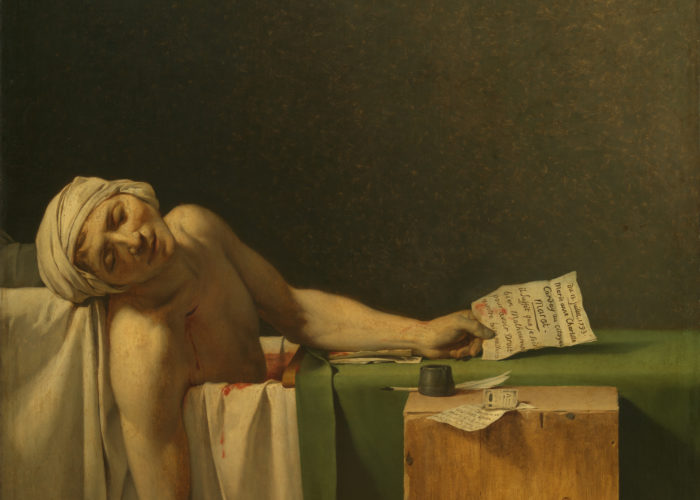The death of Marat by Jacques-Louis David
Theme: The arts in the Age of Revolution, Social and cultural revolution
Jacques-Louis David (1748-1825) was the best-known painter of historical scenes of his generation. He was a strong supporter of the French Republic and effectively became its official artist. His painting, The Death of Marat, is one of the great propagandist images of the French Revolution.
Jean-Paul Marat (1743 –1793) was best known for his role as a radical journalist and politician during the French Revolution. He was passionate about the rights of the poorer classes and they, in turn, regarded him as a hero. But Marat’s uncompromising and often violent views also led him to have many enemies. One of these was Charlotte Corday, a supporter of the Girondin political group. On 13 July 1793, Charlotte tricked Marat into allowing her into his apartment. Charlotte stabbed Marat to death in his bath (which he would lie in for hours to relieve a painful skin condition) and she was later tried and guillotined for his murder.
Jean-Jacques David, a close friend of Marat’s, was invited to paint Marat before organising his funeral. Most of the detail in the picture is embellished or symbolic but the painting succeeded in cementing Marat’s reputation among his supporters as a hero and martyr.
It was revolutionary in its subject matter but also in its design, which pushed the boundaries of conventional practice, as in the use of empty space and light to give a sacred feel to the bloody event. The painting itself fell from favour when David died and was hidden for many decades from 1795, eventually being gifted to the Royal Museum of Fine Arts in Brussels, the city which was home to the artist after his exile at the fall of Napoleon.
Did you know..?
Artist Richard Wilson recreated this painting in a video portrait in 2013, with Lady GaGa in the role of Marat.
Sources & acknowledgements
This object description and its related educational resources were researched and written by our team of historians and education specialists. For further information see the item’s home museum, gallery or archive, listed above.
- Enquiry Questions
-
Did you know..?
Artist Richard Wilson recreated this painting in a video portrait in 2013, with Lady GaGa in the role of Marat.
-
Education overview
You can access a range of teachers resources related to this object and more on our education page.
Please also see our glossary of terms for more detailed explanations of the terms used.
-
Curatorial info
- Originating Museum: Musées Royaux des Beaux-Arts at Brussels
- Production Date: 1793
- Creator: Jacques-Louis David
- Original record
-
Use this image
- Rights Holder: © Royal Museums of Fine Arts of Belgium, Brussels / photo: J. Geleyns
- License Type: All Rights Reserved



